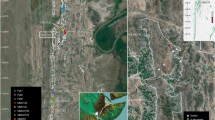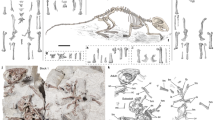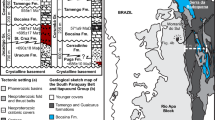Abstract
THE phylogenetic relationships of living tarsiers and extinct omomyid primates are critical for deciphering the origin and relationships of primate higher taxa, particularly anthropoids1–6. Three competing phylogenetic hypotheses are: (1) tarsiers are most closely related to early Cenozoic Omomyidae5–8, particularly genera such as Necrolemur from the late Eocene of Europe9–11; (2) tarsiers share a more recent common ancestry with anthropoids than they do with any known omomyid2–4,12,13; (3) tarsiers and/or omomyids are most closely related to strepsirhines14. The anatomy of four skulls of the early Eocene omomyid Shoshonius cooperi — the first cranial material recovered for this genus—strongly suggests that Shoshonius shares a more recent common ancestry with Tarsius than do either anthropoids or other Eocene omomyids for which cranial anatomy is known. If the primate suborder Haplor-hini (anthropoids, omomyids, tarsiids) is monophyletic, the phylogenetic position of Shoshonius requires that anthropoids and Tarsius diverged by at least the early Eocene, some 15 million years before the first appearance of anthropoids in the fossil record15–17.
This is a preview of subscription content, access via your institution
Access options
Subscribe to this journal
Receive 51 print issues and online access
$199.00 per year
only $3.90 per issue
Buy this article
- Purchase on SpringerLink
- Instant access to full article PDF
Prices may be subject to local taxes which are calculated during checkout
Similar content being viewed by others
References
Pocock, R. I. Proc. zool. Soc., Lond. 1918, 19–53 (1918).
Cartmill, M. & Kay, R. F. in Recent Advances in Primatology Vol. 3, Evolution (eds Olivers, D. J. & Joysey, K. A.) 205–214 (Academic, London, 1978).
Cartmill, M., MacPhee, R. D. E. & Simons, E. L. Am. J. phys. Anthrop. 56, 3–21 (1981).
MacPhee, R. D. E. & Cartmill, M. in Comparative Primate Biology Vol. 1, Systematics, Evolution, and Anatomy (eds Swindler, D. R. & Erwin, J.) 219–275 (Liss, New York, 1986).
Rosenberger, A. L. & Szalay, F. S. in Evolutionary Biology of the New World Monkeys and Continental Drift (eds Ciochon, R. L. & Chiarelli, A. B.) 139–157 (Plenum, New York, 1980).
Rasmussen, D. T. J. hum. Evol. 15, 1–12 (1986).
Szalay, F. S. Bull. Am. Mus. nat. Hist. 156, 157–450 (1976).
Gingerich, P. D. J. hum. Evol. 10, 345–374 (1981).
Simons, E. L. Bull. Br. Mus. (nat. Hist.) Geol. 5, 43–69 (1961).
Rosenberger, A. L. Folia Primatol. 45, 179–194 (1985).
Simons, E. L. & Rasmussen, D. T. Am. J. phys. Anthrop. 79, 1–23 (1989).
Cartmill, M. in Evolutionary Biology of the New World Monkeys and Continental Drift (eds Ciochon, R. L & Chiarelli, A. B.) 243–274 (Plenum, New York, 1980).
Schmid, P. in Primate Evolutionary Biology (eds Chiarelli, A. B. & Corruccini, R. S.) 6–13 (Springer, Berlin, 1981).
Schwartz, J. H. & Tattersall, I. J. hum. Evol. 16, 23–40 (1987).
de Bonis, L., Jaeger, J.-J., Coiffait, B. & Coiffait, P.-E. C. r. hebd. Seanc. Acad. Sci., Paris (Ser. II) 306, 929–934 (1988).
Simons, E. L. Proc. natn. Acad. Sci. U.S.A. 86, 9956–9960 (1989).
Simons, E. L. Science 247, 1567–1569 (1990).
Stucky, R. K., Krishtalka, L. & Redline, A. D. Geol. Soc. Am. spec. Pap. 243, 169–186 (1990).
Krishtalka, L. et al. in Cenozoic Mammals of North America: Geochronology and Biostratigraphy (ed. Woodburne, M. O.) 77–117 (Univ. California Press, Berkeley, 1987).
MacPhee, R. D. E. Contr. Primatol. 18, 1–282 (1981).
Szalay, F. S. & Wilson, J. A. Folia Primatol. 25, 288–293 (1976).
Conroy, G. C. Am. J. phys. Anthrop. 52, 443–451 (1980).
Simons, E. L. & Bown, T. M. Nature 313, 475–477 (1985).
Fleagle, J. G. & Kay, R. F. J. hum. Evol. 16, 483–532 (1987).
Ginsburg, L. & Mein, P. C. r. hebd. Seanc. Acad. Sci., Paris (Ser. II) 304, 1213–1215 (1987).
Gebo, D. L. J. hum. Evol. 15, 421–430 (1986).
Luckett, W. P. in Phytogeny of the Primates: A Multidisciplinary Approach (eds Luckett, W. P. & Szalay, F. S.) 157–182 (Plenum, New York, 1975).
Pollock, J. I. & Mullin, R. J. Am. J. phys. Anthrop. 73, 65–70 (1987).
de Jong, W. W. & Goodman, M. J. hum. Evol. 17, 575–582 (1988).
Koop, B. F. et al. J. biol. Chem. 264, 68–79 (1989).
Czelusniak, J. et al. in Current Mammalogy, Volume 2 (ed. Genoways, H. H.) 545–572 (Plenum, New York, 1990).
Martin, R. D. Primate Origins and Evolution: A Phylogenetic Reconstruction (Princeton Univ. Press, New Jersey, 1990).
Author information
Authors and Affiliations
Rights and permissions
About this article
Cite this article
Beard, K., Krishtalka, L. & Stucky, R. First skulls of the Early Eocene primate Shoshonius cooperi and the anthropoid-tarsier dichotomy. Nature 349, 64–67 (1991). https://doi.org/10.1038/349064a0
Received:
Accepted:
Issue date:
DOI: https://doi.org/10.1038/349064a0
This article is cited by
-
Modules and Mosaics in the Evolution of the Tetonius – Pseudotetonius Dentition
Journal of Mammalian Evolution (2020)
-
The pioneering role of PRDM9 indel mutations in tarsier evolution
Scientific Reports (2016)
-
The phylogenetic system of primates—character evolution in the light of a consolidated tree
Organisms Diversity & Evolution (2016)
-
Evolutionary morphology, cranial biomechanics and the origins of tarsiers and anthropoids
Palaeobiodiversity and Palaeoenvironments (2012)
-
Understanding Eocene primate palaeobiology using a comprehensive analysis of living primate ecology, biology and behaviour
Palaeobiodiversity and Palaeoenvironments (2012)



